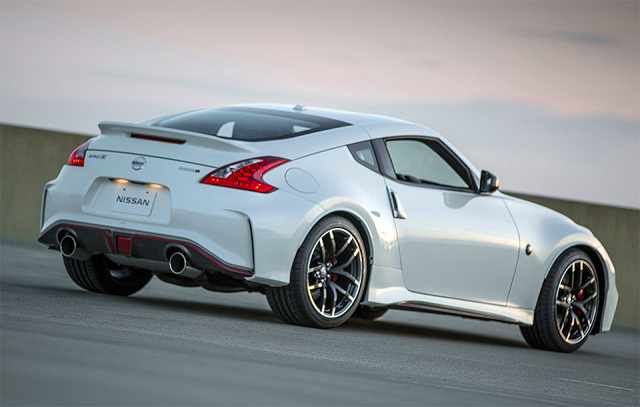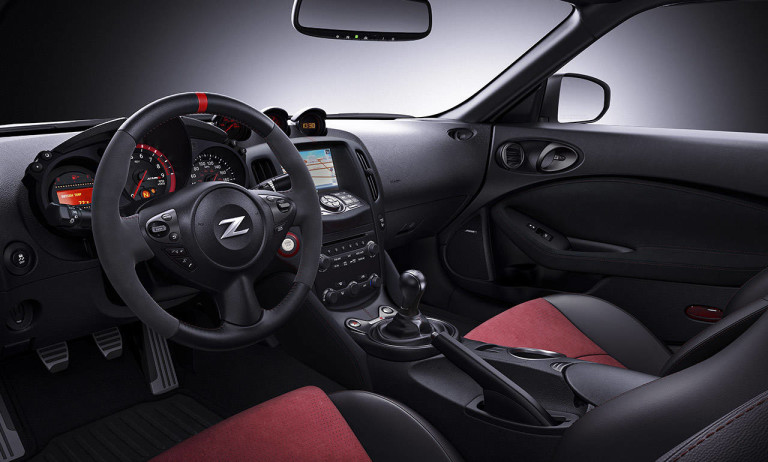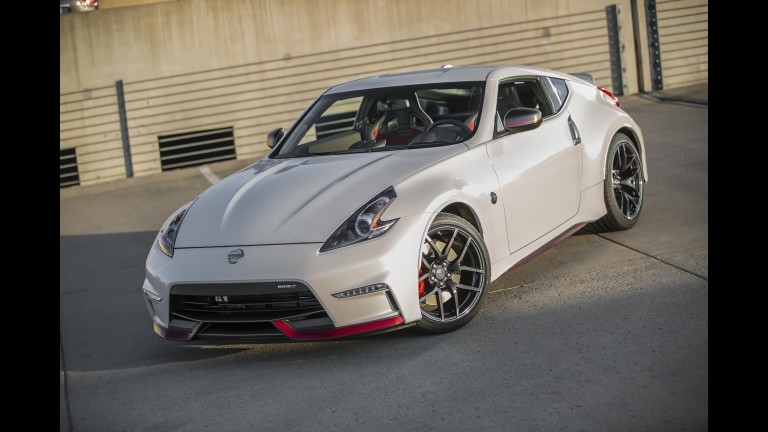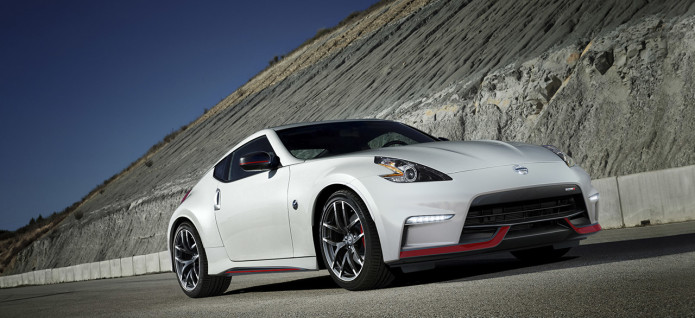THE GOOD: The 2017 Nissan 370Z Nismo’s performance upgrades transform the sports coupe into a street-legal race car. The firm suspension offers great track feel and the wide, sticky tires give plenty of grip when cornering. SynchroRev Match makes every shift a perfectly timed one.
THE BAD: The $3,500 Tech package adds outdated navigation and an eight-speaker audio system. You could do better with a smartphone. The firm ride and narrow seats are punishing over rough roads and for longer trips and the shallow trunk makes the Z impractical as a daily driver.
THE BOTTOM LINE: After experiencing it at the track, I’m seeing the 2017 Nissan 370Z Nismo in a totally new light. However, as the competition continues to refine, the Z is a tough sell for all but the most hard-core.

I can admit it: I was wrong…sort of. The last time I saw the Nissan 370Z Nismo, I didn’t love it. The ride was harsh on the street, the boy-racer aerodynamics were just obnoxious, the tech felt a decade old and the performance bump didn’t feel like it was worth the significant price bump over the standard Z.
This time, after spending a week with the 2017 Nissan 370Z Nismo, I caught myself considering buying one of my own. This car’s not so different from the one I drove before, so what gives?
Handling upgrades
The laundry list of Nismo upgrades is of the old-fashioned sort: big wheels, meaty tires, stiff suspension and naturally aspirated power. It’s not the first car that I’ve described as Japanese muscle, but it’s probably the one that fits the description best.
Working from the ground up, the Z Nismo’s upgrades start with a set of sticky Bridgestone Potenza S001 high-performance tires. The rubber is wrapped around 19-inch forged alloy wheels built for Nismo by Rays, a manufacturer of high-end racing and tuner wheels. The wheels feature a staggered fit with 9.5-inch wide rollers up front and even wider 10.5-inch wheels out back.

On display behind the wheels’ spokes are bright red sports brakes. The Nismo uses four-piston aluminum calipers on 14.0-inch discs and two-piston calipers on 13.8-inch discs for the front and rear axles, respectively. But Nissan’s tuning division didn’t stop there; it also upgraded the brake lines with rigidity hoses and filled the system with R35 Special II brake fluid to reduce fade at high temperatures such as those you’d experience at the track.
Still working up, the chassis is suspended over the rolling stock with a Nismo-tuned suspension with stiffer springs, dampers and stabilizer bars. In the engine bay, the strut towers are tied together and to the body with a reinforced 3-point brace. After all of that stiffening, Nismo has also installed front and rear chassis dampers to help cut down some of the vibration and harshness over rough surfaces. Even with the chassis dampers the Nismo is a pretty loud and rough ride over uneven pavement and city streets.
One of my biggest nitpicks with the previous iteration of the Z Nismo was that the aerodynamics package was just a bit too boy-racerish, too attention grabbing and just plain goofy looking. The 2017 370Z Nismo has a smaller rear spoiler that no longer blocks what little rear visibility the Z has to offer. The GT-R-inspired body kit is plainly more attractive than the old catfish fascia.

Inside the cabin, the driver and one passenger wedge into a set of Nismo/Recaro racing seats with Alcantara inserts. The racing buckets are gorgeous but too tight and uncomfortable on the street. On the track, however, the tall bolstering did an exceptional job of keeping my butt in place during cornering. I’d go as far as to say that they actually get more comfortable the harder the Z is pushed at the track; because I didn’t have to brace myself with my knees I was freer to see to the business of actually driving closer to the limits…either that or I was too amped up on adrenaline to notice that my bottom was aching.
Meanwhile, the steering wheel and shift lever also both get the Nismo treatment and are wrapped in Alcantara and leather, respectively.
If it ain’t broke: Powertrain upgrades
Not much has changed in the engine bay, which is just a teensy bit of a disappointment. I can continue to wish for a factory-installed and warrantied twin-turbo system, but I don’t realistically expect any drastic powertrain changes this late in the 370Z’s life cycle.
The heart of the Z Nismo is essentially the same naturally aspirated, 3.7-liter VQ-series engine (VQ37VHR) V6 engine that powers the standard 370Z. It’s basically a tweaked and higher displacement version of the VQ35DE that’s powered the Z since the 2003 launch of the 350Z. Nissan puts some variant of the VQ into everything from the Frontier pickup to the Maxima sedan; it’s a proven and reliable powerplant if nothing else and Nissan seems to be taking an “if it ain’t broke, don’t fix it” approach to this element of the Z Nismo’s performance.

In the Z Nismo, output has been massaged to 350 horsepower and 276 pound-feet of torque (up from the standard 370Z’s 332 horsepower and 270 pound-feet of torque) thanks to more aggressive tuning. Fuel economy is stated at 26 highway mpg and 18 city mpg.
The 370Z Nismo comes standard with a six-speed manual transmission with a feature called SynchroRev Matching. When shifting up or down range, the Z’s computer can hold or automatically blip the throttle, matching the engine speed with your new transmission speed for smooth shifting. It’s sort of like an electronic heel-and-toe. If you don’t like the computer intervention, the SynchroRev Matching system can be defeated with a single button press, but I actually found that I liked it. The Rev Matching made me feel like a racing god without getting in my way.
There’s also a seven-speed automatic transmission with paddle shifters available, but people will laugh at you when they peek into your Z and only see two pedals.
Rounding out the Nismo upgrades is a viscous limited-slip differential on the rear axle that makes sure that both of the Z’s meaty rear tires share the load under stress and effectively do their job when accelerating out of a corner.
Let’s get this over with…the tech
The 370Z Nismo’s cabin technology is better than the last time I saw it but still pretty terrible. But since tech’s not even near the point of this car, I’m grading it on a generous curve this time. but that’s not the point.
All of the electronic doodads are lumped into an all-or-nothing Tech trim level that bumps up the MSRP by $3,500. This package includes the Nissan HDD Navigation — which still looks a decade old despite many small improvements — Bose Audio with eight speakers and a HomeLink transceiver for gate and garage door openers. This is pretty basic stuff for a $3,500 Tech package, and you could easily do better with a mount for your smartphone.

The gem of the Tech trim level is the inclusion of a rearview monitor — the sole driver aid feature you’ll find in the Z’s list of options. Thankfully, the camera’s feed now outputs to the center display, rather than a tiny monitor set into the rearview mirror. That camera alone is almost worth the cost of the Tech trim level’s admission thanks to the Z’s terrible rear visibility, but $3,500 buys a lot of track days and tires. I’d personally think twice before checking that box.
Attack the track
The Z Nismo just comes alive and makes sense on a race track. I suppose I shouldn’t be surprised based on the length of the “Handling Upgrades” section of this very review.
The sports coupe puts its power to the road with surprising efficiency and possesses an ungodly amount of just plain mechanical grip when cornering. It’s no wonder; those 285/35YR19 rear tires give the Z more contact patch on just its rear axle than many cars have at all four corners. Forget complicated computer-controlled traction systems, jamming the widest stickiest tires you can find beneath the arches is how you make grip!
The 370Z Nismo is an easy car to trust at the track because of its old-school mechanical approach to performance. Without much computer intervention — save the SynchroRev Matching and standard, defeatable traction control — I never found myself at odds with what an electronic brain thought I was trying to do.

The more confident I felt around the track, the more capable the Z Nismo felt. When I made a mistake, the Z would let me know so I could learn from it for the next lap.The flip side is that if I made a big mistake, there’s not much of a safety net to save my bacon, but that adds a nervous energy to the experience that I love. My daily driver is a compact roadster that doesn’t even have ABS, so I can appreciate Nissan’s simple approach to performance.
There’s a good amount of feel through the steering wheel, excellent support from the Recaro bucket seat and consistent performance from the suspension and brakes. I was able to lap the car for hours without any noticeable brake fade; I think I got tired before the car did.
The handling limits are generous if maybe a bit ill-defined at the limit. The car would understeer a bit if pushed too hard, but oversteer rarely presented itself unless I either specifically asked for it or was particularly hammy on the throttle — the meaty tires feel like a good match for the engine. Within the limits and at my skill level, the Z felt eager to rotate around an axis that seemed to go straight through my spine. Rear and side visibility wasn’t great, but the car was still easy to place exactly where I wanted it on the track.

An aging prizefighter
The entirety of my 2014 Z Nismo test took place on the street but the thing that really changed my mind about this 2017 Nissan 370Z Nismo is that this outing involved a long day lapping on a wide-open racetrack. So, while I was right last time that the Z Nismo is pretty terrible on the street, I was also wrong to call it a disappointment because it turns out that the only way to truly appreciate this car is to take it on the track and really just flog the hell out of it. I’m seeing this car in a totally new light.
Potential buyers should weigh whether the terrible tech, punishing ride on the street, poor visibility rearward and parkability and middling mpg are worth the excellent closed course performance. Basically, if you’re not going to hit the track regularly, think twice about the Nissan Motorsports model.
The 2017 Nissan 370Z Nismo starts at $41,990 plus $865 destination charges, a substantial jump up from the standard Z’s $29,990 base price. The top-tier Z only really offers two options that aren’t dealer-installed styling upgrades: a $520 set of Nismo brake pads for the track and the Tech trim level that adds a $3,500 bump to the bottom line.

The best true current competitors to the 370Z Nismo, in my opinion, are American pony cars. The Asian competition is lacking since the Hyundai Genesis Coupe exited the market and the European sports coupes are all more expensive (and more luxurious) than the aging 370Z.
For the around $46K that this Z Nismo stickered at, you could buy one heck of a Ford Mustang GT with the Performance package for the track, much better Ford Sync 3 tech, an actual trunk for your daily errands and have bucks left over for mods. Another favorite alternative of mine is the Dodge Challenger R/T Scat Pack which is nowhere near as good as the Z or the ‘Stang on the track but offers much more power for bragging rights and those traffic light drag races, similar fuel economy around town and a much more livable ride and accommodations.
The 370Z Nismo is like an aging prizefighter. It’s getting a bit long in the tooth and around town it can be a bit of a lumbering brute. You may think it awkward, outdated and maybe even a bit stupid. But when it steps into the ring, the Z Nismo takes on a grace you wouldn’t have thought possible. It’s still got some impressive footwork and there is a practiced intelligence and experience behind its still impressive performance.
(cnet.com, https://goo.gl/UwKCwm)


